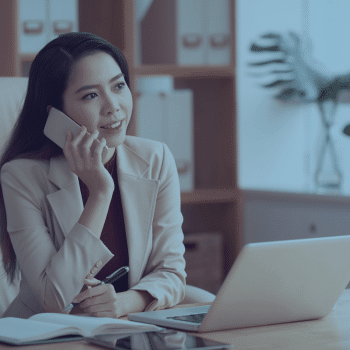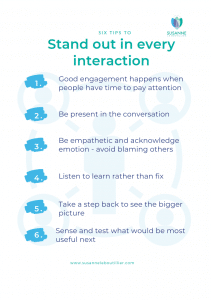People can make the mistake of thinking stakeholder engagement only happens as part of a project or change initiative. If a stakeholder is any person or group that can affect or is affected by your organisation’, then opportunities for effective stakeholder engagement arise continually.
Stakeholders can be internal or external to your organisation.
Stakeholders can have a high level of interest in what you are doing because they are directly affected by the outcome (primary stakeholders) or generally interested/involved but not directly affected by the outcome (secondary stakeholders).
They might be directly involved day to day, e.g. employees (direct stakeholders), or only interested in the finished outcome rather than the process leading up to the outcome, e.g. customers (indirect stakeholders).
No matter which category your stakeholders fall into, you will always have stakeholders where you only get one small chance to leave an impression.
Make a great impression, and another stakeholder might hear about it.
Make a bad impression, and you can almost guarantee word will spread.
Then, there is the stakeholder where you have time to build a relationship, much like a bank account. A relationship where you have a series of positive interactions to build the credit in your account. If something goes wrong and the stakeholder has a less than ideal experience, you hope the credit you built up is greater than the damage done.
Remember, every interaction counts, especially if you need to build up credit in case of a rainy day.
Given this, I thought I would share some tips I learned working with stakeholders in different contexts and from diverse backgrounds over many years.
Broadly, my tips fall under six key headings:
- Good engagement happens when people have time to pay attention.
- Be present in the conversation.
- Be empathetic and acknowledge emotion during stakeholder engagement – avoid blaming others.
- Listen to learn rather than fix.
- Take a step back to see the bigger picture.
- Sense and test what would be most useful next.
I will cover the first three tips in this blog and the other three tips in a later blog post.
Tip 1 – Good engagement happens when people have time to pay attention
Phone calls
How many times has someone called you when you are distracted?

Instead, they are most likely to experience your response as dismissive and uncaring.
You could try to brush them off as quickly as you can so you can get back to what is most important to you right now.
Or you could be honest and show you respect your relationship by having the courage to explain it is not a good time to talk.
You do not have to share why. Unless you know the stakeholder well enough to share you are currently:
- neck-deep in analysing data that does not look right, and your boss wanted the answer two hours ago.
- or you are trying to organise food for your child who left their school lunch at home AGAIN.
Often saying less is better. I have learnt that over-explaining does not help and can negatively affect how you are perceived.
Gather your confidence and say something like:
‘I want to speak with you, unfortunately now is not a good time, can I call you back later today or in the morning?’
Then add calling them back to your to-do list and make sure you follow through. If you genuinely cannot make the call when you said you would, send a short email or text to give an update so the stakeholder knows when they can expect to hear from you.
 Emails
Emails
Some people are great at politely putting what they need into an email and then there are the people who make your hackles rise as soon as you read their message.
When you receive one of ‘those’ emails, resist the temptation to shoot back a scathing reply and refrain from denying their request because you can.
Take a deep breath, and a moment to think about what they probably meant to say, then draft a response.
Save it, but do not send it.
Wait a couple of hours or, if it is a stinker, until you have had a chance to cool down.
Reread your draft reply. Does it respond to the issue raised rather than the content of the email? If so, send it. If not, keep editing your response until it does. If in doubt, ask someone else to read your reply before hitting send.
Do not be pressured into responding straight away unless it is unavoidable.
If the person emailing you seems distressed or needs to know you have seen their email send them a short acknowledgement email. You could try something like:
‘Thank you for your email. I have read it and will send a response as soon as possible‘.
Tip 2 – Be present in the conversation
Minimise distractions
When you speak with someone, minimise your email window, so you are not tempted to review emails popping up in your inbox. Do the same with any social media platforms in your line of sight or turn over the document you reviewed before you answered the phone.
People can tell from your voice when you are reading and speaking to them. It is no different from feeling someone is friendly because they smile when you talk to them over the phone.
If you are in an open plan environment and likely to be interrupted, explain you need to move to a different area so you can speak to them without interruption. It helps to make sure you have ground rules in place with the people around you, so they know to be quiet and avoid disturbing you when you answer the phone.
Most of all, make sure the person on the other end of the phone feels they have your undivided attention.
Notice what is going on in the conversation
Noticing what is going on in a conversation sounds simple, but it takes practice. You can only adjust your response once you notice what is happening. Start with trying to notice what is going on with you and the other person.
Notice what is going on with you when engaging with stakeholders
What are you thinking but not saying?
For example:
‘I would not like that happening to me‘ – empathy.
‘That cannot true’ – not sure the person is truthful.
‘’Here we go again’ – do I need to listen as I’ve heard it before.
‘When will I have the time to do that‘ – irritation.
What are you feeling?
For example, you might be:
- tensing your neck and shoulder
- getting hot and sweaty under your arms
- rolling your eyes
- shaking your head, or
- scrunching your face.
Make sure to ask yourself why you are reacting this way. What is at stake for you, and how is that affecting how you respond?
Notice what is going on with the stakeholder when you engage with them
Put yourself in the other person’s shoes and imagine what it is like for them.
Be careful to avoid telling yourself simple stories that blind you to the truth. Jennifer Garvey-Berger suggests looking for three different stories about what is going on for the person to avoid making simple assumptions that prevent you from seeing what is going on.
Think about what the other person is not saying and what they are feeling during stakeholder engagement.
My client had a stakeholder very upset they were unable to sit an exam on the scheduled date. However, as soon as the client noticed what was going on with the other person, it was clear the other person was assuming the worst possible outcome. The other person was an international medical graduate (IMG) with specific visa requirements. Stories the IMG might have been telling themselves could have included:
- I missed my exam, and now Immigration will cancel my visa.
- No one else in my family can work in Australia, and I am about to lose my job.
- I gave up everything to come to Australia, and it has been for nothing.
It is easy to see how the quality of the interaction could quickly deteriorate in this situation.
Once you begin noticing what is going on, shift how you respond.
Reflect on how that affects the other person’s reaction and the quality of stakeholder engagement.
Tip 3 – Be empathetic and acknowledge emotion during stakeholder engagement – avoid blaming others
When I was actively involved with Queensland University of Technology’s Fostering Executive Women (FEW) I was fortunate to be exposed to Dr Jeannie Kahwajy, who taught me two valuable concepts.
- The one thing you can control is how you choose to respond, and
- Inviting someone to respond in the way you would like can have a pleasantly surprising impact.
Imagine you are in an exchange with a very concerned stakeholder about some changes your organisation is making that will directly affect them. You notice they are upset because the volume and pace of their speech is increasing, and their voice has an angry tone.
What should you do when a stakeholder is upset?
You could choose to match the volume, pace, and tone of your voice to theirs. However, you know if you do, the quality of the interaction will go rapidly downhill.
In this situation, the first thing I would do is remain calm and avoid mirroring how the other person is speaking.
Next, I would invite the person to respond the way I want, by saying:
‘I can tell this is very concerning for you. Can we please slow down? I want to take the time to understand what this change means for you. As you explain it to me, I will probably ask you some questions to make sure I understand what is most important for you’.
Then listen to learn, rather than fix.
If you are hard-wired to fix problems, avoid conflict, or please other people you are at significant risk of rushing to reach an agreement with your stakeholder. Agreeing sounds like a good thing to do; however, the reality is you can miss out on better ways to manage an issue.
Rushing to reach agreement stifles good conversations. Try to create space to explore a range of options or approaches before deciding on one. You should still acknowledge what appear to be viable options. Then make it clear you see the benefit in exploring the issue more deeply, to create a safe space that invites the other person to keep exploring the problem with you.
You might even find it deepens your relationship and improves the quality of your stakeholder engagement.
Experimenting with your stakeholder engagement
In this blog, I have suggested three tips you can use to make sure your interactions with stakeholders stand out – the right way.
Tip 1 – Good engagement happens when people have time to pay attention
Tip 2 – Be present in the conversation
Tip 3 – Be empathetic and acknowledge emotion during stakeholder engagement – avoid blaming others.
Give some thought to how you can safely try some of these out, especially with people you can ask for feedback afterwards.
Remember, skills development takes practice.
Do you need stakeholder engagement support?
Reach out if you want to work on how you engage with your stakeholders. I have a wealth of personal experience working with stakeholders in complex and challenging situations. I also assist organisations in understanding the nature of their relationships with stakeholders and working with them to develop strategic stakeholder engagement plans.
You can find out more about me at www.susanneleboutillier.com
Want a poster with all six tips?
Join my mailing list to receive this A4 poster to help you remember these tips next time you receive a poorly timed or challenging call or email.



 Emails
Emails








